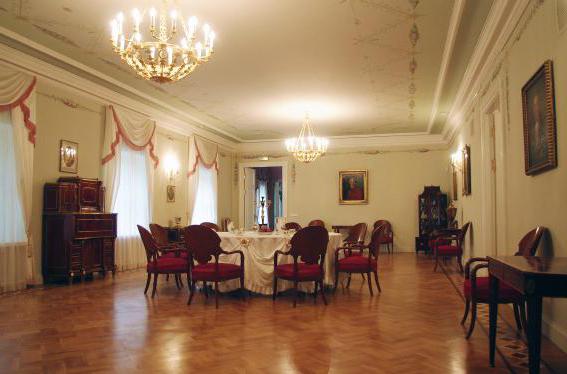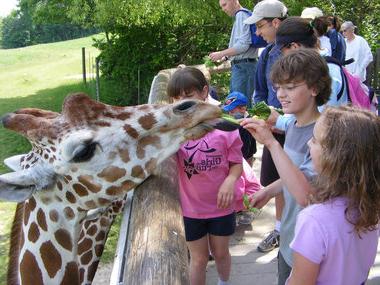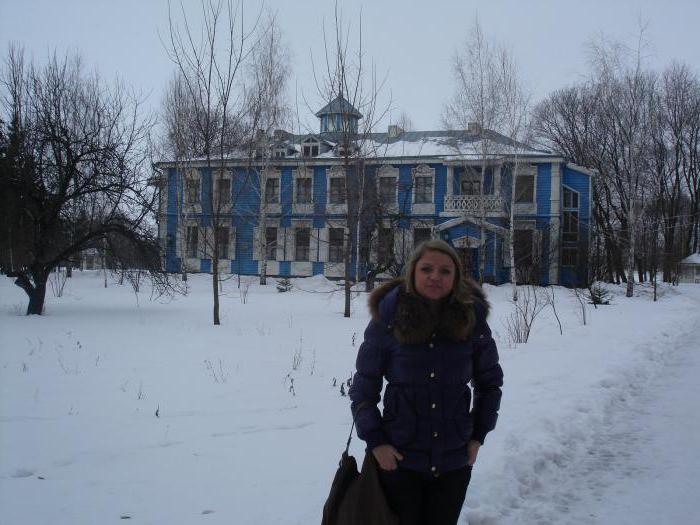Derzhavin Museum-Estate in St. Petersburg
Petersburg architecture of the old city hasown guardian angel, otherwise it's hard to explain how some buildings managed to survive. After surviving the revolution, war, neglect, and sometimes human desire to destroy, the city has preserved its uniqueness. Derzhavin Museum-Estate in St. Petersburg has been rebuilt many times to meet the needs of new times and owners, but survived, and this generation has the opportunity not only to pass through the halls, but also to touch the brilliant era.
House for the poet
The modern house-estate Derzhavin on Fontanka waswas acquired by the poet in 1791. The building was under construction, which gave a chance to design and decorate the interior according to the taste of the new owners. Gavrila Romanovich Derzhavin asked for the completion of work for the architect and his long-time friend, NA L'vov, who gladly took up the job.
The scale of construction was rather big, besidesplanned completion of office space. By 1794 the finishing works were finishing, the stable and kitchen appeared in the estate, the architect and architect Pilniakov was working on the project. Unfortunately, the hostess of the house, Ekaterina Yakovlevna Derzhavin, who put her soul in the house, by the time all the works were completed, died. After her, there was evidence of her quivering attitude towards the new dwelling. Wanting to equip a family nest, but at the same time experiencing financial difficulties, she kept a record of all expenses in the "Book on the cost of money for a stone house. From August 1791 ».
Settled in a house on the Fontanka, Derzhavin created inits special atmosphere. At the turn of the 18-19 centuries the house was famous for its hospitality and was considered a center of culture. Since 1811 in the "Dance Hall" of the manor there are regular literary readings, meetings of like-minded people. At the end of the 18th century Derzhavin Museum-Estate was replenished with the theatrical stage, for which the building was equipped. The productions involved family members, close friends and famous professional actors of their time.

The Magic Garden
In addition to plans for the construction and decoration of the house, inthe architect's task was to equip the garden. In terms of the estate, several greenhouses are designated, each of which was given to the same culture - peaches, pineapples, etc. Part of the land was allocated for greenhouses, where thermophilic plants, exotic fruits, flowers grew. There was a small home garden, from which they harvested a crop of traditional crops (potatoes, rutabaga, beets, peas, cucumbers, radish and others).
The architect Lvov also dealt with the breakdown of the garden andchoice of trees. In his design, the garden should be a magnificent setting for a majestic house. In the park were planted trees such as lindens, maples, birches, oaks, etc. The garden was adorned with the lilac and jasmine bushes, as well as the more familiar ones: viburnum, dogrose, honeysuckle. The flower garden was composed mainly of bulbous, rare at that time, cultures - hyacinths, lilies, daffodils, many rose bushes were planted.

The Catholic period
After the death of the owners of the museum-estate Derzhavin inSt. Petersburg for several years was empty. The Roman Catholic Spiritual College acquired a mansion in 1846. For the organization's purposes, luxury and cozy halls were not needed, so the work on redevelopment immediately began. They were conducted under the supervision of the architects AM Gornostaev and VI Sobol'shchikov.
According to new tasks, Derzhavin Museum-Estategot an additional floor above the house and outbuildings, the colonnade was dismantled, the facade design was changed. The internal premises were deprived of the main front staircase, some rooms received partitions and other changes. Later, the greenhouses were destroyed, and the construction of the Church of the Assumption of the Virgin Mary (1870-1873) deprived the estate of vegetable gardens and most of the garden.
During the following time the museum-estate of G. Derzhavin was rebuilt several times. So, in 1901 it was required to finish the third floor above both wings, the works were conducted by the architect L. P. Shishko.
Revolution and housing issue
After the revolution, from 1918 to 1924,the museum-estate of G. R. Derzhavin was abandoned, the authorities could not find a targeted use for it. Then it was decided to give it to the house, which was finally ruined by the remains of the interior. The house was densely populated, new partitions were required, tenants carried out repairs according to their own tastes and possibilities.
Ponds in the park fell asleep by 1935. The garden of the manor from the regular turned into spontaneous, where plantings were conducted without any plan or idea. So the situation lasted a long time, for sure in St. Petersburg you can find people who lived in communal homes. At the end of the 20th century, the estate had offices of numerous companies and several residential apartments, the basement of a 2.5-meter-high house was flooded with water for years. The decision to restore and transfer the architectural heritage to the museum of Pushkin was made in 1998.

Museum status
The museum-estate of Derzhavin and Russian literature wasIt was opened in 2003, after global restoration works in the central building. In total, sixteen rooms were opened, where the restorers tried as accurately as possible to recreate the situation of the Derzhavin house. They relied on the testimonies and descriptions of contemporaries, the surviving records of the poet himself.
In different parts of the country there were genuinepieces of furniture from the estate: part was provided by the All-Russian Pushkin Museum, some items were transferred for temporary storage by the Tretyakov Gallery and many other repositories. In Derzhavin's house they proudly display the authentic table, the written device of the poet, you can also see several author's autographs, personal items and the famous portrait of the owner of the house of the Tonchi brush.
Restoration work continued until 2007and were crowned with the opening of a home theater in the main building and two outbuildings. With them, the central building is connected by covered galleries, each wing has its own name, derived from the original designation - Kitchen, Konyushenny and others. Now they have exhibition galleries and concert halls.
From 2009 to 2011 there were heldrestoration work in the park. The central greenhouse reappeared on the surviving basement, the garden was cleaned and its historical appearance recreated, where the meadow occupies a central place, the creek rang again, three ponds were restored.

Infrastructure
Museum-Estate Derzhavin today - an impressive complex. It includes:
- Central building. There is a museum of G. Derzhavin and the Russian literature of his time in the room. There is a permanent exhibition, which consists of 16 rooms on two floors.
- East building. The first floor was given for a permanent exhibition "The owners of the Russian lira. From Derzhavin to Pushkin. " The second and third floors invite visitors to the exhibition halls of the Pushkin Museum, where materials are presented that are not included in the permanent exhibition.
- The Western Corps. On the ground floor there is an exposition "The All-Russian Museum of AS Pushkin. Pages of History "(permanent). On the second floor there are several rooms for creative evenings and meetings, a media center with a collection of unique materials. On the third floor you can visit the permanent exposition "In the white gloss of porcelain", there are also several exhibition halls where the works of masters of different times, including our contemporaries, are regularly presented.
- Home theater. Reconstructive productions, musical and creative meetings are held in the hall.
- Manor garden. On the territory of the park, sightseeing tours are conducted, and the park zone is used as an open concert platform for musical and theatrical productions.
- Central greenhouse. After the restoration has received other functions, today here are conducted literary readings, musical evenings, lectures are given.
- Hotel. Located on the territory of the manor complex in the guest house, the interior is decided in the spirit of classicism with a full set of modern comforts.

Permanent exhibitions
The Derzhavin Museum-Estate (St. Petersburg) invites to visit permanent exhibitions:
- "The owners of the Russian lira. From Derzhavin to A. To S. Pushkin ". During the excursion, visitors are introduced to the exposition of genuine portraits of writers, philosophers, books published during the 18-19th centuries, and objects of art. Among the rarities is one of the volumes of the Encyclopaedia Diderot and D'Alembert, objects of decorative and applied art. The cost of tickets for adults - from 200 rubles., For students and pensioners - from 100 rubles. For schoolchildren under 16 years - from 60 rubles.
- "In the white gloss of porcelain." The exposition is located in several halls. In the first porcelain of the turn of the 17-18 centuries of the Chinese school is presented. The rest is given to Russian porcelain produced by various manufactories. Samples of objects of the Imperial Porcelain Factory, private factories are presented. Admission price for adults - from 120 rubles. For pensioners and students - from 60 rubles., Children under 16 years old, attend the exhibition without a tour for free.
Also in the museum there are excursion programs: "On a visit to the owner of the house", "Derzhavin and music", "I heard you for the first time ...", a sightseeing tour of the manor garden and others.

Educational activities
The museum-estate Derzhavin is extensivescientific activities, developed and operate many programs for schoolchildren of all ages. The program "Traveling with a cat scientist in Pushkin Petersburg" is held outside the museum walls, is aimed at younger schoolchildren. During the excursion, the students get acquainted with the history of the city, children in interactive form demonstrate the influence of the city on the poet's work.
The game "Derzhavin's cuisine" offersget acquainted with the device of everyday life in the life of the poet, the guide shows household items, talks about the arrangement of furnaces and much more, no less entertaining. The program is designed for the average school age.
In the arsenal of the museum and its employees is locateda lot of author's programs, supplementing school education, helping to develop a love of literature and Russian literature. Adults will also find a lot of new things.

Helpful information
The All-Russian Pushkin Museum consists of sixbranches, among them is Derzhavin Museum-Estate. Fontanka was lucky with the inhabitants once, and now there are many monuments of architecture attracting compatriots and citizens of other countries.
To touch the era of Derzhavin, Pushkin,Nekrasov, it is worth to visit the museum halls and get carried away by true stories. The museum-estate of Derzhavin has the following address: embankment of the Fontanka River, building 118.
</ p>




